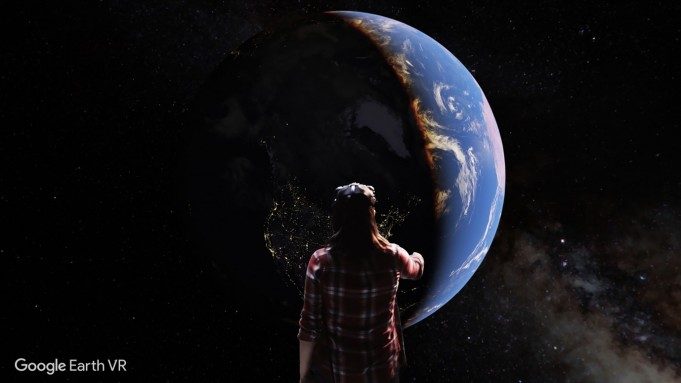 Google Earth VR has been one of the most mind-blowing experiences that I’ve had so far in VR, for so many different reasons. It’s felt like it’s been rewiring my brain to accommodate the new perspectives of the Earth in a way similar to what returning astronauts report as “The Overview Effect.” It’s also enabled me to navigate the Earth based upon natural landmarks and without seeing borders, and therefore start to cultivate a new type relationship with the Earth. It’s also allowed to find common ground with friends and strangers by sharing stories that are based upon geographic locations, and it’s one of the most intimate and powerful social VR experiences that I’ve had so far.
Google Earth VR has been one of the most mind-blowing experiences that I’ve had so far in VR, for so many different reasons. It’s felt like it’s been rewiring my brain to accommodate the new perspectives of the Earth in a way similar to what returning astronauts report as “The Overview Effect.” It’s also enabled me to navigate the Earth based upon natural landmarks and without seeing borders, and therefore start to cultivate a new type relationship with the Earth. It’s also allowed to find common ground with friends and strangers by sharing stories that are based upon geographic locations, and it’s one of the most intimate and powerful social VR experiences that I’ve had so far.
 I had a chance to do an interview with Mike Podwal, Product Manager for Earth VR as well as Dominik Kaeser, Engineering Lead on Earth VR to ask them about their design process. They focused primarily on performance, comfortable navigation, and an overall immersive experience of the earth. They weighed the tradeoffs between simplicity vs. usefulness in looking at what features to implement, and very few of their beta testers requested an explicit search functionality. They instead preferred to do organic exploration and navigate based upon landmarks in a way that provides a new perspective and relationship with the Earth. In the future, they will be looking at the 2D version Google Earth for inspiration for new features such as annotation, but they also are open to feedback for the types of features that people are requesting. You can hear a lot more insights and stories behind the process of creating Google Earth VR in the interview below.
I had a chance to do an interview with Mike Podwal, Product Manager for Earth VR as well as Dominik Kaeser, Engineering Lead on Earth VR to ask them about their design process. They focused primarily on performance, comfortable navigation, and an overall immersive experience of the earth. They weighed the tradeoffs between simplicity vs. usefulness in looking at what features to implement, and very few of their beta testers requested an explicit search functionality. They instead preferred to do organic exploration and navigate based upon landmarks in a way that provides a new perspective and relationship with the Earth. In the future, they will be looking at the 2D version Google Earth for inspiration for new features such as annotation, but they also are open to feedback for the types of features that people are requesting. You can hear a lot more insights and stories behind the process of creating Google Earth VR in the interview below.
LISTEN TO THE VOICES OF VR PODCAST
Google Earth VR is a powerful asymmetrical social VR experience where people can watch a 2D screen of someone in VR who is telling stories about their life or giving guided tours. Sharing stories based upon geographic locations has been a powerful way for me to find common ground with both friends and strangers. Google Earth VR feels like one of first real killer apps of VR that has made me want to share the process of annotating the earth with layers of meaning with my friends and family, and it will likely inspire a lot of people to buy their first high-end VR system.
Google Earth VR maps out the earth at many different scales ranging from human scale to being able to see entire countries. Being able to seamlessly navigate the entire globe at any one of these scales has provided something that no human has been able to really experience before, and so my brain has been stimulated in a way that feels like many new neural connections have been forged. It’s stimulated my mind with new ideas and insights unlike any other experience I’ve had before, and seems to make the explicit connection between geography and the architecture of memory. It’s also personally validated the concepts of embodied cognition theory that suggest that our cognitive processes are influenced both by our mind and body but also our environment. Google Earth seems to provide enough fidelity to your mind at the human scale to be able to evoke powerful memories, and I found myself efficiently mapping out the emotional landscape through the process of flying over my hometown in a way that I could never do before.
Google Earth VR is a free application for the Vive on Steam VR, and so I had a couple of follow up questions for Google after my interview. I asked them: “What kind of data can and cannot be collected given Google’s standard Privacy Policy within a VR experience?” and “Are there long-term plans to evolve Google’s Privacy Policy given how VR represents the ability to passively capture more and more intimate biometric data & behavioral data?”
Here is Google’s response:
Our users trust us with their information and we outline how it may be used across Google — to personalize experiences, to improve products, and more — in our Privacy policy. Users can control the information they share with Google in ‘My Account’.”
I didn’t see any explicit privacy settings related to virtual reality yet, and this is really the first application that they’ve released that starts to raise some of these deeper questions for me. I’ll be talking to more privacy and biometric data experts to get specific information about some of my concerns.
I believe that we are moving from the information age into the experiential age. Within the information age, we gave explicit consent over data that could be provided through a form. In the experiential age, companies can track head gaze and hand motions, and eventually eye gaze, emotional states, heart rate, and EEG data. As the founder of OpenBCI has suggested, EEGs and potentially other biometric data may have a unique signature that can’t be anonymized as easily and could have additional privacy concerns down the road.
These open questions about biometric data and privacy are long-term open question for the entire VR industry, as well as how to sustain vast experiences like this. I personally believe that new business models may have to be developed to really sustain these new types of services like Google Earth VR and other experiences in the metaverse. But for now, it’s an amazing service to humanity to provide this service free of charge for the world, and I expect that it will blow a lot of minds and inspire a lot of people to try out VR for the first time.
Overall, Google Earth VR has been one of those experiences that has really stuck with me and inspired me to reach out and share it with friends. It’s been a profoundly intimate way to get to know someone by having them take you on a guided tour of their locations on the earth that mean the most to them. By prioritizing immersion, Google Earth provides a completely new way of navigating the Earth the can provide some totally new perspectives. This is also an ambitious design effort that starts to explore entirely new interfaces and user experience paradigms that give a glimpse of where immersive computing is headed in the future.
This is just the first iteration of Google Earth VR, and the quality is just going to get better and better. However, I personally have my doubts that it’ll ever get to the full resolution of the Earth with all of it’s constantly changing dynamic processes. But I’ve already started to see and appreciate the earth in a new way, and it’s inspired me to want to travel and pay more attention to the beauty that’s all around me.
Google Earth VR is available for free on Steam.
Support Voices of VR
- Subscribe on iTunes
- Donate to the Voices of VR Podcast Patreon
Music: Fatality & Summer Trip







